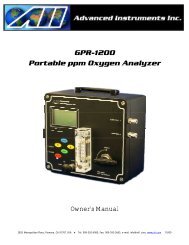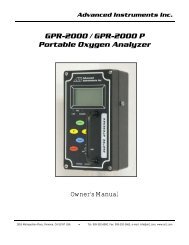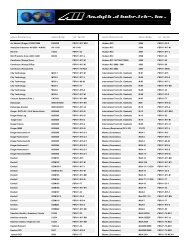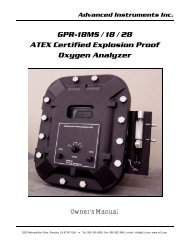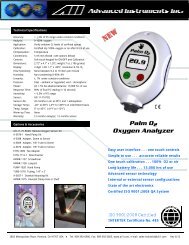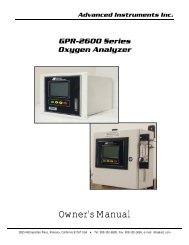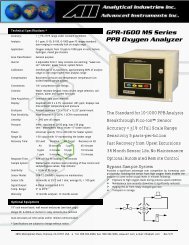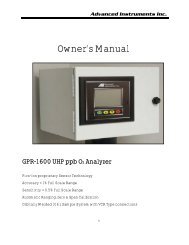GPR-1800 AIS ATEX Trace PPM Oxygen Analyzer - Advanced ...
GPR-1800 AIS ATEX Trace PPM Oxygen Analyzer - Advanced ...
GPR-1800 AIS ATEX Trace PPM Oxygen Analyzer - Advanced ...
- No tags were found...
You also want an ePaper? Increase the reach of your titles
YUMPU automatically turns print PDFs into web optimized ePapers that Google loves.
<strong>Advanced</strong> Instruments Inc.3. Ensure the positive and negative terminals of the power supply are connected to the appropriate terminals of the barrierstrip as marked.4. Connect the shielding of the cable to the ground screw inside the enclosure. Note: The terminals snap together, making itpossible to detach the section with the ground, install the shielded cable and reinstall.5. Replace the cover.6. The 4-20mA current output is obtained by connecting the current measuring device between the positive and negativeterminals labeled OUTPUT 4-20mA.7. To check the signal output of the 4-20mA E/I integrated circuit connect an ammeter as the measuring device and confirmthe output is within +0.1mA of 4mA.8. Caution: To assure proper grounding, connect the 4-20mA signal output to the external device (PLC, DCS, etc.) beforeattempting any zero or span adjustments.Installing the <strong>Oxygen</strong> SensorThe <strong>GPR</strong>-<strong>1800</strong><strong>AIS</strong> ppm <strong>Oxygen</strong> Transmitter is equipped with an integral oxygen sensor.They have been tested and calibrated by the manufacturer prior to shipment and are fullyoperational from the shipping container.Caution: All transmitters must be calibrated once the installation has been completed andperiodically thereafter as described below. Following the initial installation and calibration,allow the transmitters to stabilize for 24 hours and calibrate with certified span gas.Caution: DO NOT open the oxygen sensor. The sensor contains a corrosive liquidelectrolyte that could be harmful if touched or ingested, refer to the Material Safety Data Sheet contained in the Owner’sManual appendix. Avoid contact with any liquid or crystal type powder in or around the sensor orsensor housing, as either could be a form of electrolyte. Leaking sensors should be disposed of inmanner similar to that of a common battery in accordance with local regulations.Procedure:1. The sensor has not been installed at the factory (in standard configuration there are no valvesto isolate the sensor) and it will be necessary to install the sensor in the field.2. Caution: Do not change the factory settings until instructed to do in this manual.3. Connect the gas lines as previously described.4. Purge the oxygen trapped in the newly connected gas lines for 3-5 minutes.5. Flow zero gas or sample gas with a low ppm oxygen concentration to the analyzer at thepredetermined flow rate of 2 SCFH.6. Using the 5/16 wrench supplied loosen but do not remove the clamp bolt located under thesensor housing, see photo.7. Rotate the upper section of the sensor housing 90º to disengage from the clamp.8. Remove the upper section by pulling it straight up and place it on a smooth surface.9. Select the AUTO RANGING option from the SAMPLE menu with gas flowing to the analyzer.10. Remove the oxygen sensor from the bag and remove the red shorting device (including the gold ribbon) from the PCBlocated at the rear of the sensor. Minimize the time the sensor is exposed to ambient air.11. Immediately place the sensor in the bottom section of the sensor housing with the PCB facing up.12. Immediately place the upper section of the sensor housing over the sensor, gently push the upper section downward androtate 90º to engage the clamp.13. Finger tighten the clamp bolt and then tighten it one full turn with the 5/16 wrench to securely lock the two sections of thesensor housing.14. The analyzer will OVER RANGE for a short period of time as indicated by the graphical LCD display.15. Wait until the display shows a meaningful oxygen reading and begins to approach the expected oxygen content of thesample gas.Span Gas PreparationCaution: Do not contaminate the span gas cylinder when connecting the regulator. Bleed the air filled regulator (faster andmore reliable than simply flowing the span gas) before attempting the initial calibration of the instrument.13



